‘Behemoth’ is a word which springs to mind or, perhaps more nautically, ‘leviathan’.

2019 was an auspicious year in New Zealand, although thinking back to those heady pre-Covid days sometimes hurts the brain. But it was the year that Stryda Marine was finally able to commercially launch their first model, the 600C amphibious catamaran. Their four-wheel-drive technology was a challenge to the incumbent players in this space, and we reviewed that boat just before Christmas of that year.
After two extended lockdowns it feels like a whole lifetime later, but incredibly just 2 years have passed and it was almost exactly the same time of year when Stryda put the finishing touches on their new baby, the 900C amphibious. And so just before Christmas we had the pleasure of taking a new Stryda out to play, once again turning heads by launching off a North Shore beach in Auckland.

The 900C is a much larger boat than their first model, and this time features a more conventional deep-vee monohull design while retaining the same hardtop layout with an open cockpit. This model was developed in a collaborative process that involved the prospective purchaser approaching Stryda with some specific requirements. Ross and his wife Katrina have owned one of the other brands of amphibious boat for some time and are now ready to upgrade.
The process took his input and combined it with the extensive inhouse amphibious craft knowledge of Stryda’s design team, complimented by Stimson Marine Design and Naval Architecture. Further input from Kit Carlier Design contributed both technical and modern approaches to create the ‘Stryda Design DNA’, etched in the 900C’s package.
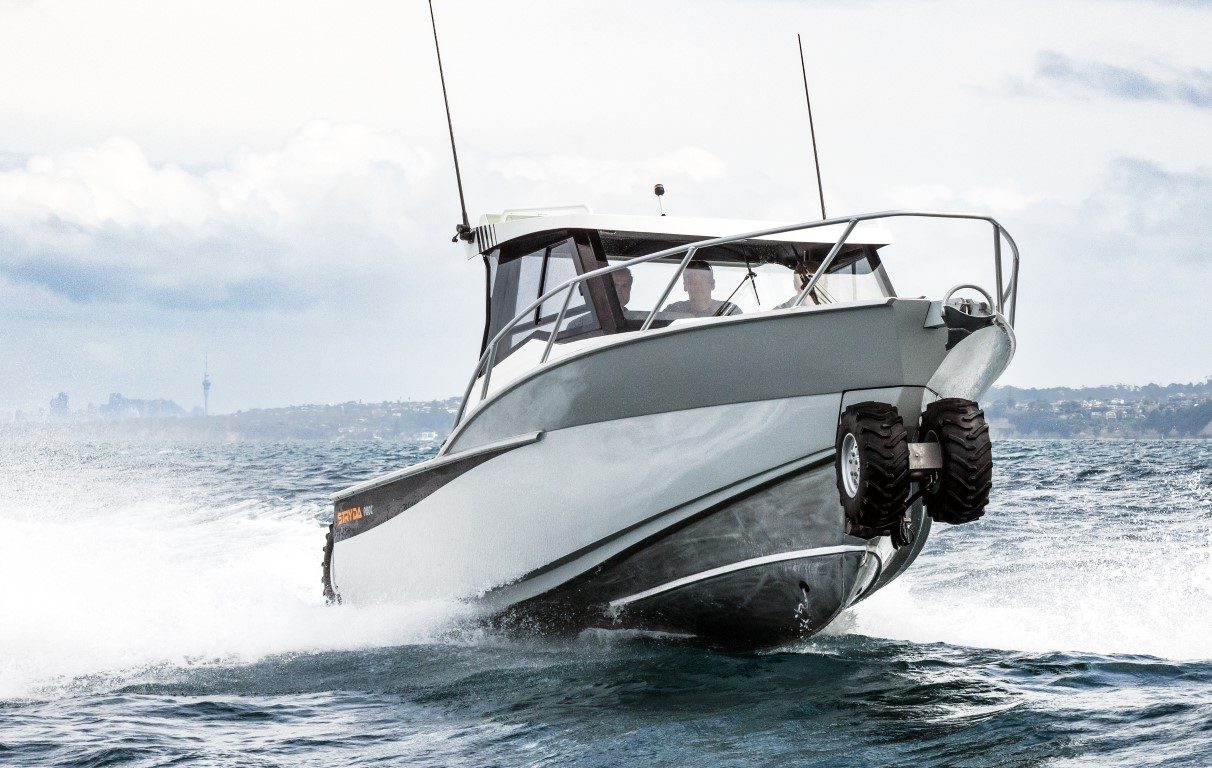
The funtional requirements were for a large-volume dive and fishing platform, with more shelter, a few more creature comforts and a greater range. He wanted a vessel that could take on the sometimes-big seas of Mercury Bay and the Eastern Coromandel. At the same time, he wanted to retain the convenience of the launch-anywhere amphibious drive, meaning he could load the boat up with gear and people at his bach and drive it down to the beach and straight into the water. The 900C is the result of that collaboration.
This model gets its amphibious capability from the same Orion Gen2 all-time four-wheel drive technology as the smaller stablemate. The double front wheel provides better lateral stability and improved grip and the ability to navigate challenging terrain over other technologies which have a single front wheel. The anti-stall system maintains constant wheel RPM when transitioning between land and sea though its class leading torque. The sealed hydraulics, engineered in marine grade Alloys and coatings, include a traction control system to eliminate slip on challenging terrain.

Advanced PLC controllers continuously monitor the amphibious functions, and smart brakes with a standby park function ensure the boat will not roll away if left unattended. New features of the Gen2 system on this craft include the auto wheel up/wheel down function, along with automotive joystick drive that delivers a simple yet seamless operation for the user. An integrated colour display shows all the parameters of the drive system along with its self-check monitoring.
Of course, the larger and different shaped hull has resulted in a few changes as well. The bigger transom does a better job at hiding the 40hp petrol engine that drives the hydraulics for the wheels. A convenient bench seat intruding into the cockpit is the only indication of the secrets hidden below the hatch.
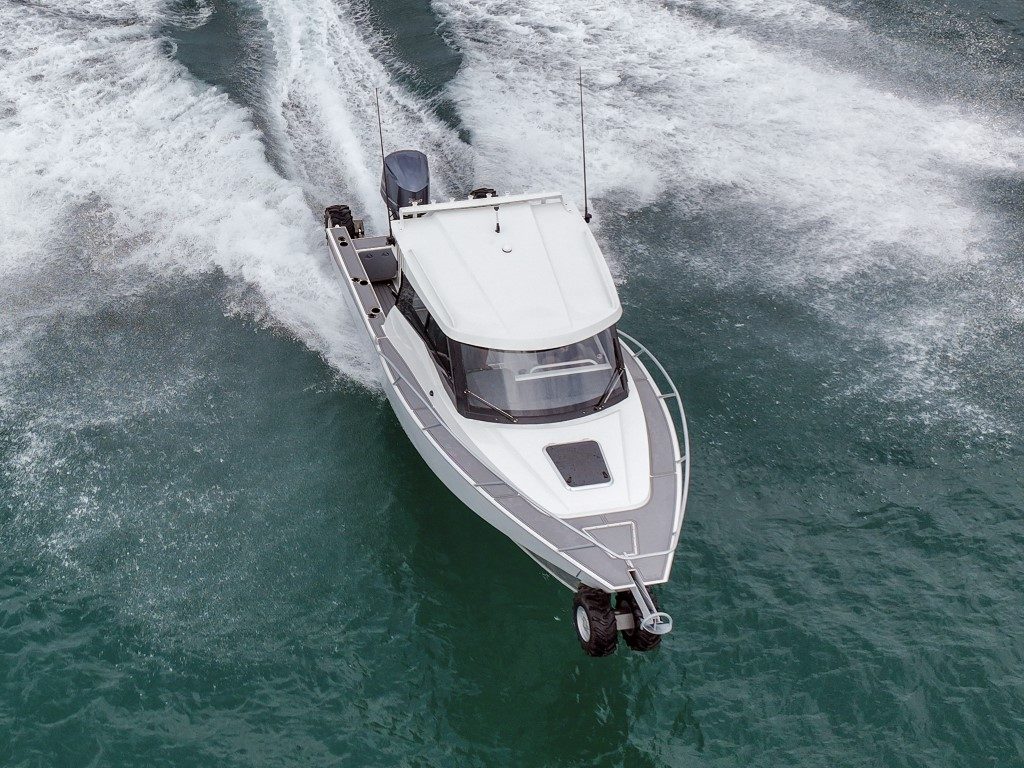
Outside the cockpit, the rear driving wheels retract up against the transom as before, but up in the bow the monohull design means the wheel does not have a tunnel to hide in. Instead, the drive unit pulls up snugly below the flared bow which has a neat squared off section, while the wheels tuck up one on either side. This is well clear of the water while under way, and no spray comes off the wheel assembly.
Inside the spacious forward cabin there was absolutely no evidence of the drive mechanism. The Orion technology is compact and hence no interior space is sacrificed. The forward cabin is huge, with a wide 3-berth bed hiding a plumbed toilet under the removable squabs. This was specified as an absolute must-have by the new owner, since this is intended as a family boat capable of occasional overnight trips.
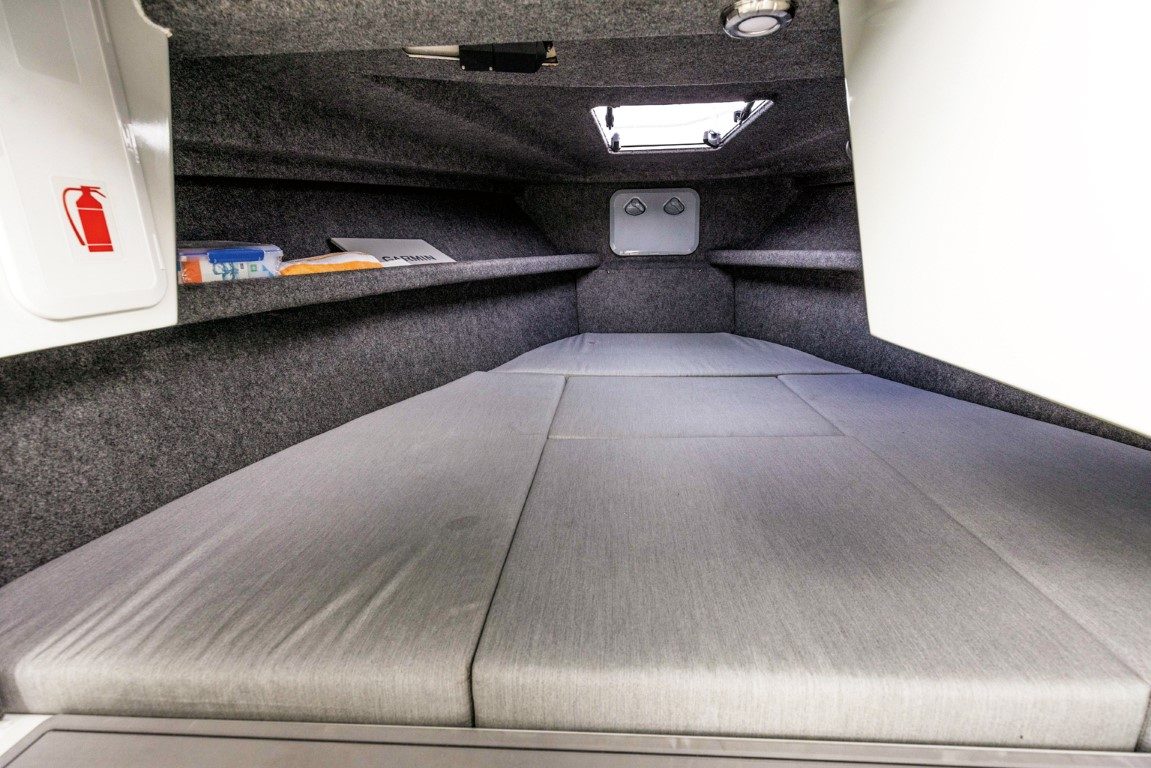
The main cabin under the hardtop features a pair of very generous king-and-queen pedestals holding the fully-adjustable skipper and passenger seats, plus two lower rear-facing passenger seats. Space under these accommodates a chilly bin and storage locker. The helm is a smart white layout with a bank of conventional switches, all with custom labels. A large Garmin multi-function display provides fishfinder and chartplotter capability, plus does duty as a video screen for displaying output from the driving camera tucked under the bow.
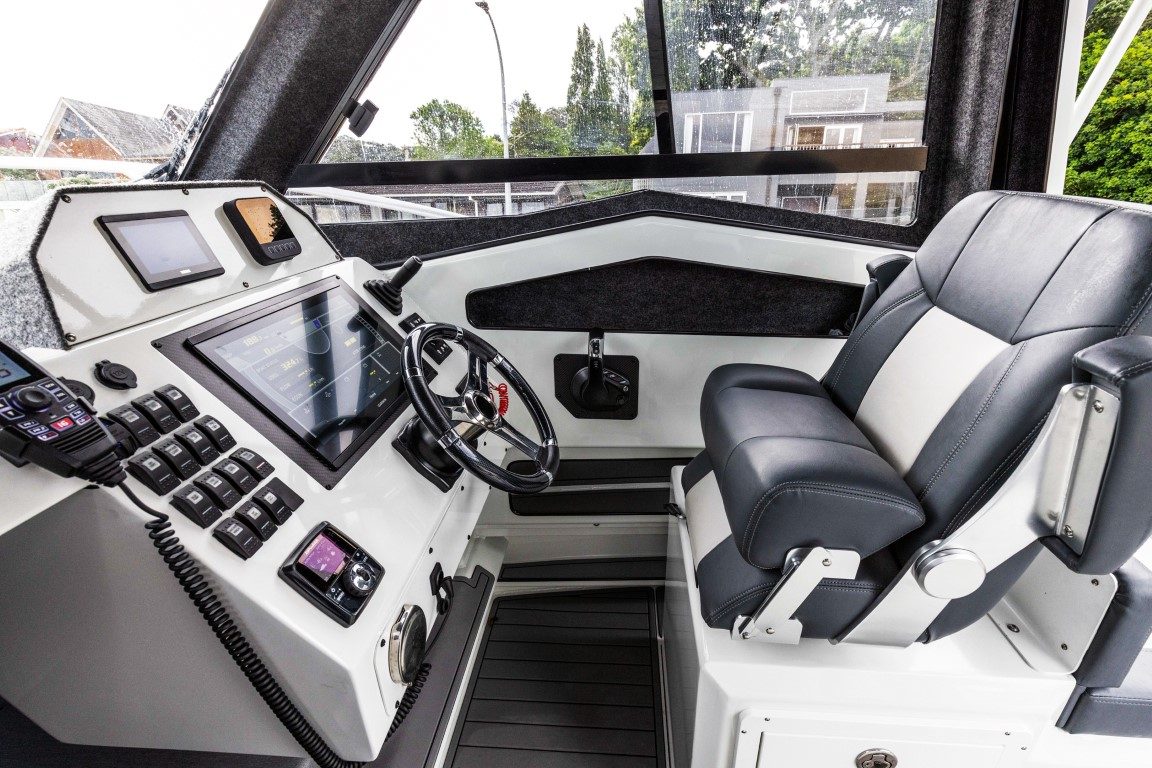
At the top of the helm are two digital engine displays, one for the Yamaha outboard and the other from the Orion amphibious drive. A small set of switches and that joystick to the right are used to control the wheels. A nice feature of the layout is the use of the GME “Black Box” VHF radio, with the actual radio tucked behind the helm and all VHF funtions accessible on a single handset. This saves dash space and is extremely practical. A set of Zipwake trim tabs is fitted, and the controller for this completes the helm layout.
The whole cockpit floor is covered in custom-cut soft vinyl panels, easy on the feet while retaining a secure footing even when wet. Another nice touch is that the lined parcel shelves either side of the cockpit run the full length of the cockpit without any dividers, enabling the safe storage of delicate fishing rods. Of course, a huge number of rod holders in the gunwales and a large rocket-launcher along the hardtop provide storage when on the water.

As we noted with the previous model, the built quality of Stryda boats is exceptional. All exposed metal surfaces are painted and flawless. Apart from that deck covering, the cabin sides and roof are carpeted for warmth and sound absorption. The upholstery is excellent quality, and we could not fault the fit-out. Being the first version of this new model, a few minor tweaks are still being made, such as improving the drip channels along the rear of the hardtop, but overall, the boat works really well
Hanging off the back of the boat on review day was a Yamaha 250 four-stroke outboard, but new owner Ross has ordered the latest model 300hp V6 model. Supply chain issues meant that this had been delayed, hence the 250 was installed for sea trials. Despite the lower horsepower during our test the boat was still capable of a top speed just under 40 knots, astonishing for a 9m boat. She also cruises comfortably at 25 knots. Ross said he did consider going for the 350hp V8 model but decided the extra weight was not worth the potentially extra performance over the V6. We certainly could not see any reason for needing that extra power unless the boat is going to normally be very heavily laden.

Our review day was pretty choppy, as the photos will attest. We chose these conditions specifically because the new owner wanted to test her seaworthiness in big seas, and he pronounced himself well satisfied. Certainly, we cut through same massive swells, landing again comfortably with no drama. She turns very well, heeling exactly as expected and can pull a pretty tight circle. The volume of the boat meant we were stable and comfortable despite the conditions, and indeed at the end of the review the photographer decided he would rather come home with us than head home on the magazine’s photo boat!
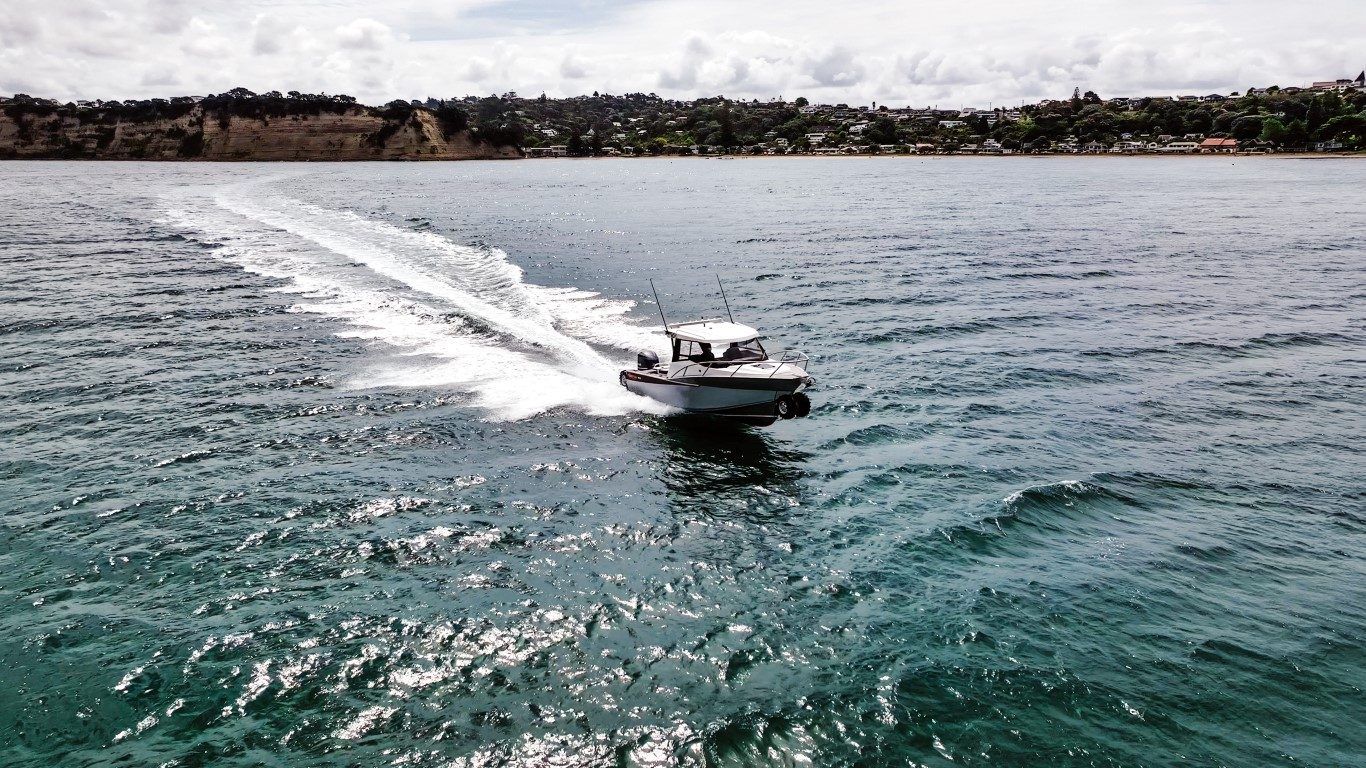
The fly-by-wire electronic controls and power assisted steering make it extremely easy to control the boat, and the skipper’s position was comfortable either standing or when seated. The hardtop has plenty of head-height and even when flying through big swells there was no danger of hitting your head.
Driving the boat up unto a beach on Whangaparoa Peninsula was no drama whatsoever, apart from collecting a small crowd of interested onlooker. At least two people stopped their cars when the saw us and came over to enquire about the boat, which attests to the statement she made. The controls for the amphibious drive were intuitive and make it easy to transition from land to water and vice versa.

The Stryda 900C is a fantastic boat, and is one of the largest amphibious alloy boats currently available in New Zealand. The four-wheel-drive technology gives her a sure footing out of the water, while that great hull gives her a comfortable ride in it. The build quality is superb, and this is a boat that you will be proud to take family and friends out on.

‘Behemoth’ is a word which springs to mind or, perhaps more nautically, ‘leviathan’.
White Pointer has earned the respect of discerning customers in New Zealand and Australia, attracting a loyal and ever growing following for its high-quality, rugged and totally dependable aluminium trailer boats.
The hardtop SP635 shares the same underpinnings as the popular SF 635 which was a completely new model back in 2020.
The pride and joy of a multi-generational family, Bliss resides on a pier that’s home to a couple of other Elite motor launches – Sandspit Marina is a hot-spot for the Bill Upfold-designed vessels, with several calling this small marina home.